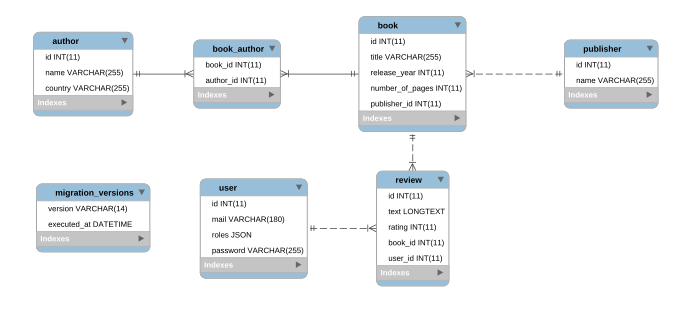Softwerkskammer Magdeburg: Making Web Apps with PHP Symfony, Hendrik Pilz

Making Web Apps with

Softwerkskammer Magdeburg
Hendrik Pilz
<?php print_r($me); ?>
stdClass Object
(
[name] => Hendrik
[worksAt] => rundum.digital
[codingSince] => 1998
[languages] => Array
(
[0] => PHP
[1] => HTML
[2] => CSS
[3] => JS
[4] => Java
[5] => SQL
[6] => ...
)
)
Was ist Symfony?
«Symfony is
a set of PHP Components,
a Web Application framework,
a Philosophy,
and a Community —
all working together in harmony.»
Das Framework
- Model-View-Controller
- ORM mit Doctrine
- Templates mit Twig
- Konfiguration mittels Annotationen (meistens)
Agenda
- Setup
- Projekt BookDB
- Let's make it
- Zusammenfassung
Setup
- Windows, Linux oder MacOS
php7.3 (www.php.net)composer- PHP Paket Manager (getcomposer.org)- MySQL oder MariaDB (mysql.com, mariadb.org)
Projekt BookDB
- Datenbank für Bücher, Authoren und Rezensionen
Let's make it
$ mkdir bookdb
$ cd bookdb
$ composer create-project symfony/website-skeleton .
$ php bin/console server:run
Datenbank-Verbindung
DATABASE_URL=mysql://user:password@127.0.0.1:3306/dbname
.env-Datei im Projektverzeichnis
$ php bin/console doctrine:database:create
optional
Entity User
$ php bin/console make:user
$ php bin/console make:migration
$ php bin/console doctrine:migrations:migrate
Registration Form
$ php bin/console make:registration-form
http://localhost:8000/register
$ php bin/console doctrine:query:sql "SELECT * FROM user"
Login Form
$ php bin/console make:auth
http://localhost:8000/login
Der erste Controller
$ php bin/console make:controller
onAuthenticationSuccess() in Authenticator-Klasse anpassen
Das erste Entity: Book
$ php bin/console make:entity
$ php bin/console make:migration
$ php bin/console doctrine:migrations:migrate
Weitere Entities
- Author
- Publisher
- Review
Entities verbinden
- Book Author @ManyToMany
- Book Publisher @ManyToOne
- Book Review @OneToMany
- Review User @ManyToOne
$ php bin/console make:entity
$ php bin/console make:migration
$ php bin/console doctrine:migrations:migrate
Ein Blick in die Datenbank
- MySQL Workbench (www.mysql.com/products/workbench/)
- Database Reverse Engineer

CRUD
- Create form
- List view (Read)
- Update form
- Delete form
$ php bin/console make:crud
Object could not be converted to string

public function __toString() {
return $this->title;
}
Book.php, bei anderen Entities entsprechend anpassen
Bootstrap hinzufügen (1)
- unterstützt v3 und v4
<link rel="stylesheet" type="text/css"
href="{{ asset('css/bootstrap.min.css') }}" />
im <head> in templates/base.html.twig
Bootstrap hinzufügen (2)
<script type="text/javascript"
src="{{ asset('js/bootstrap.min.js') }}"></script>
{% block javascripts %}{% endblock %}
vor </body> in templates/base.html.twig
Bootstrap hinzufügen (3)
{% form_theme form 'bootstrap_4_layout.html.twig' %}
in allen _form.html.twig
{% form_theme form 'bootstrap_3_layout.html.twig' %}
{% form_theme form 'bootstrap_3_horizontal_layout.html.twig' %}
{% form_theme form 'bootstrap_4_horizontal_layout.html.twig' %}
alternative Form-Templates
Review Form anpassen (1)
- Eingabe für "User" entfernen
- NumberType für "rating" mit "html5" = true
public function buildForm(FormBuilderInterface $builder,
array $options) {
$builder->add('title')
->add('text')
->add('rating', NumberType::class, [
'html5' => true
])
->add('book');
}
ReviewType.php
Review Form anpassen (2)
- Range-Constraint für "rating" in Review-Entity definieren
use Symfony\Component\Validator\Constraints as Assert;
/**
* @ORM\Column(type="integer")
* @Assert\Range(min = 1, max = 10)
*/
private $rating;
Review.php
Review Form anpassen (3)
- User im Controller zuweisen
/**
* @Route("/new", name="review_new", methods={"GET","POST"})
*/
public function new(Request $request): Response
{
$review = new Review();
$review->setUser($this->getUser());
$form = $this->createForm(ReviewType::class, $review);
// [...]
}
ReviewController.php
CUD-Operationen schützen
use Sensio\Bundle\FrameworkExtraBundle\Configuration\Security;
/**
* @Route("/new", name="review_new", methods={"GET","POST"})
* @Security("is_granted('ROLE_USER')")
*/
public function new(Request $request): Response
{
// [...]
}
in allen Controller-Klassen nach Bedarf
Security Voter für Reviews (1)
- User dürfen nur ihre eigenen Reviews bearbeiten
$ php bin/console make:voter
Security Voter für Reviews (2)
class ReviewVoter extends Voter {
protected function supports($attribute, $subject) {
return in_array($attribute, ['EDIT'])
&& $subject instanceof Review;
}
protected function voteOnAttribute($attribute, $subject,
TokenInterface $token) {
/* @var $subject Review */
$user = $token->getUser();
// if the user is anonymous, do not grant access
if (!$user instanceof UserInterface) {
return false;
}
switch ($attribute) {
case 'EDIT':
return $subject->getUser()->getUsername()
=== $user->getUsername();
}
return false;
}
}
ReviewVoter.php
Security Voter für Reviews (3)
public function edit(Request $request,
Review $review): Response
{
$this->denyAccessUnlessGranted('EDIT', $review);
// ...
}
ReviewController.php
REST API (1)
- OpenAPI-kompatible REST-API mit api-platform
$ composer require api
REST API (2)
- Entities als API-Resourcen deklarieren
/**
* @ORM\Entity(repositoryClass="App\Repository\BookRepository")
* @ApiResource
*/
class Book {
// ...
}
REST API (3)
- Online API-Dokumentation unter /api
- oder im OpenAPI-Format
$ php bin/console api:openapi:export > api.json
$ php bin/console api:openapi:export --yaml > api.yaml
Zusammenfassung
- Benutzte Komponenten:
- Console (inkl. MakerBundle)
- Dependency Injection
- Doctrine ORM
- Form
- Routing
- Security
- Templating
- Validator
- Developer Server & Toolbar
- REST API
Was gibt es noch?
Vielen Dank!
Diese Präsentation ist hier verfügbar
www.hepisec.de/swk-symfony/